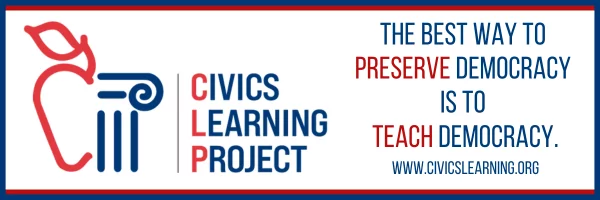CLP Current Event: April 23, 2019
Electoral College: antiquated or timeless? Read about some of the various perspectives in this week’s CLP CE!
Brought to teachers by Susie Marcus, CLP consultant, with CLP staff.
News Sources
Poll: Majority of U.S. voters support direct election: Arizona senator opposes measure, by Matt Roy, YourValley.net, April 16, 2019
“A majority of U.S. voters and some Arizona lawmakers continue to support measures to change voting rules, so future Presidents are elected by direct popular vote — not by a majority of the Electoral College.”
The Electoral College is a one-fourth compromise, by Jake Gloth, DU Clarion, April 15, 2019
“An electoral college process does not allow fair representation of every individual. An Electoral College creates a system in which each voter’s ballot is not treated equally. In the 2012 presidential election a Wyoming voter, when weighed as a part of the Electoral College, was worth 2.87 California voters. One may think this is bad enough, but based on the current system, a Texan’s vote is worth less than one-fourth of a Wyoming voter.”
CLP: Opinion
The Electoral College is trending. Guess why, by Dick Polman, Whyy, March 20, 2019
“In a report 50 years ago, the American Bar Association said that presidents should be elected by the popular vote, and that the Electoral College should be abolished because it’s ‘archaic, undemocratic, complex, ambiguous, indirect, and dangerous.’”
CLP: Opinion
The National Popular Vote, Explained, by Alex Cohen, Brennan Center for Justice, March 14, 2019
“Colorado, New Mexico, and Delaware just became the latest states to take a stand against the Electoral College and join the National Popular Vote Interstate Compact (NPV, or the Compact). The NPV is a multi-state agreement that, when active, would ensure that the presidential candidate who wins the popular vote nationally also wins in the Electoral College.”
In Defense of the Electoral College, by Allen Guelzo, National Affairs, Winter 2018
“The Electoral College was designed by the framers deliberately, like the rest of the Constitution, to counteract the worst human impulses and protect the nation from the dangers inherent in democracy. The Electoral College is neither antiquated nor toxic; it is an underappreciated institution that helps preserve our constitutional system, and it deserves a full-throated defense.”
Questions to Consider
- What is the electoral college?
- What were the Framers thinking when they created this system to elect the President? Is that thinking important today?
- How has the electoral college been modified? What is the Twelfth amendment?
- How can the Electoral college system be changed?
- What are the best arguments for keeping the Electoral College as it is?
- What are the best arguments for replacing the Electoral College?
- What is the National Popular Vote movement?
Background and More
The Electoral College: Pros and Cons, ProCon.org, September 1, 2017
Electoral College, History.com, February 25, 2019
Lesson Plans
Debating the Electoral College, by Rachel Roberson, The Lowdown
CLP: Middle School
Exploring the Electoral College, Carolina K-12
CLP: Middle School
Constitutional and Legal Connections
Electoral College, Legal Information Institute, Cornell School of Law
The Twelfth Amendment, by Sanford Levinson, National Constitution Center
The Electoral College, Thirty-Thousand.org, 2004
Oregon Connections
Readers respond: Small states have electoral advantage, The Oregonian, April 17, 2019
Oregon set to become 15th state to award all its Electoral College votes to popular vote winner, by Tom Embury-Dennis, Independent, April 11, 2019
Oregon State Social Science Standards
8.8 Evaluate information from a variety of sources and perspectives.
8.17 Examine the development activities of political parties and interest groups and their affect on events, issues, and ideas.
8.21 Analyze important political and ethical values such as freedom, democracy, equality and justice embodied in documents such as the Declaration of Independence, the United States Constitution, and the Bill of Rights.
8.26 Examine a controversial event, issue, or problem from more than one perspective.
HS.27 Examine functions and process of United States government.
HS.30 Analyze the roles and activities of political parties, interest groups, and mass media and how they affect the beliefs and behaviors of local, state, and national constituencies.
HS.33 Explain the role of government in various current events.
HS.35 Examine the pluralistic realities of society (e.g., race, poverty, gender and age), recognizing issues of equity, and evaluating need for change.
HS.59 Demonstrate the skills and dispositions needed to be a critical consumer of information.
HS.60. Analyze an event, issue, problem, or phenomenon from varied or opposing perspectives or points of view.
We the People Lesson Connections
Middle School, Level 2
- Unit 5, Lesson 25: How has the right to vote expanded since the Constitution was adopted?
- Unit 6, Lesson 29: What are the rights and responsibilities of citizenship?
- Unit 6, Lesson 30: How might citizens participate in civic affairs?
High School, Level 3
- Unit 3, Lesson 20: How has the right to vote been expanded since the adoption of the Constitution?
- Unit 6: What challenges might face American constitutional democracy in the Twenty-first century?


